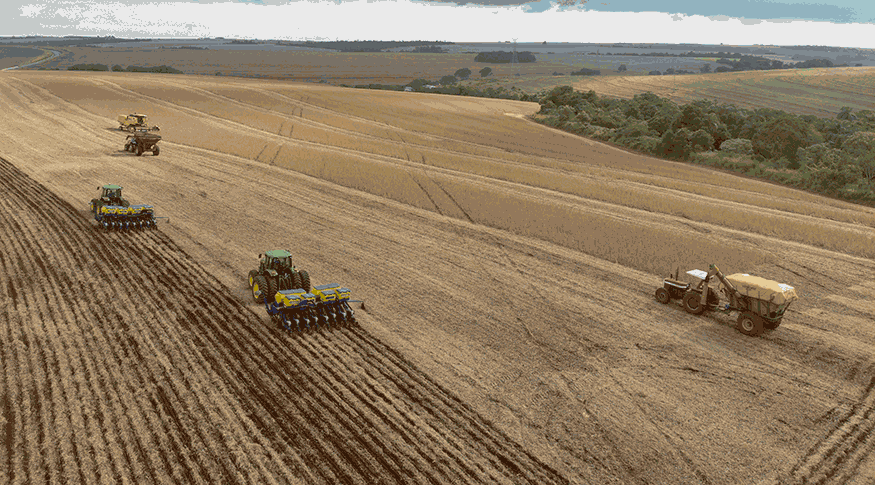Agricultural production
With a drop of 2.8%, grain harvest is expected to reach 306.5 million tonnes in 2024
January 10, 2024 09h00 AM | Last Updated: January 15, 2024 06h48 PM

The national harvest of cereals, legumes and oilseeds is expected to reach 306.5 million tonnes in 2024, a drop of 2.8% from 2023 (8.9 million tonnes), according to the third estimate of the Systematic Survey of Agricultural Production (LSPA), released today (10) by the IBGE,
The decrease is related to the lower estimate expected, mainly for corn 2nd crop, with a drop of 12.8% (-13,213,938 t); corn 1st crop, with a reduction of 3.3% (924,768 t), sorghum (-12.1% or -519,550 t) and upland cottonseed (-3.3% or – 254,688 t).
On the other hand, increase is expected for the production of soybeans (1.7% or 2,559,514 t), beans (4.2% or 123,142 t), rice (1.6% or 162,209 t) and wheat (33.0% or 2,557,315 t).
As for the expected area, increases must be observed in the areas for paddy rice (4.9%), wheat (0.6%), upland cottonseed (0.2%), beans (4.0%) and soybeans (0.9%). There must be decreases in the areas for sorghum (-2.3%), corn 1st crop (-5.0%) and corn 2nd crop (-4.3%).
“It is worth mentioning the fact that 2023 had a record output (315.4 million tonnes), which results in a higher basis for comparison. In 2023, there was record production of soybeans for corn, sorghum and cotton. In 2024, a record is estimatedfor soybeans (154.5 million tonnes, an increase of 1.3% from November, and an increase of 1.7% against the amount produced in 2023, which must represent almost half of the total cereals, legumes and oilseeds produced in Brazil in the year. The recovery of crops in Rio Grande do Sul was the main factor accounting for this increase,” says the manager of LSPA, Carlos Barradas.
He highlights that the impact of climate-related events in 2023 for the grain harvest in 2024, which resulted in an excess of rainfall in Paraná and in Rio Grande do Sul and drought in the Major Regions of North and Central West. Nevertheless, in the 2023 harvest there was a drop in output of winter products - wheat, oats and barley, with a reduction of production quality as well due to the excess of rain.
“In 2024, due to climate problems, we might have a decrease in the planting window of corn 2nd crop, main period of production for this cereal. However, since the first estimate, we have been expecting a reduction in the output of corn due to the fall of prices and climate problems. Last year, except for Rio Grande do Sul, agricultural output was high in almost every state. The positive news is that raifall is back. But we can hardly exceed the harvest of 2023,” he adds.
Against the 2nd estimate, increase amounted to 0.1%, that is, more than 317,834 tonnes.
Estimate of December for harvest in 2023 reaches 315.4 million tonnes
The 12th estimate for 2023 reveals a record production, which reached 315.4 million tonnes, 19.8% above that of 2022 (263.2 million tonnes), an increase of 52.2 million tonnes.
The area to be harvested was of 77.8 million hectares, representing a growth of 6.3% against the area harvested in 2022, an increase of 4.6 million hectares. As for the estimate of November, the area to be harvested increased by only 15,346 hectares (0.0%).
The estimated production of soybeans was 152.0 million tonnes. As for corn, the estimate was 131.1 million tonnes (27.7 million tonnes for corn first crop and 103.3 million tonnes for corn 2nd crop). The output of rice was estimated at 10.3 million tonnes, that of wheat, at 7.8 million tonnes, that of upland cottonseed, at 7.7 million tonnes and that of sorghum, at 4.3 million tonnes.
“In the 2023 harvest, except for Rio Grande do Sul, the climate was benefitial to crops; prices were high at the time of planting, and the producer believed in the process, expanded area for planting and invested in technology. The increase from 2022 reached 19.8%, which is equivalent to 52.2 million tonnes more. It seems 2024 will have a “more normal climate”, with scarcity of rainfall in some important states for the production of grain,” Mr. Barradas says.
About the LSPA
Launched in November 1972 aiming at addressing the demand of users for monthly short-term statistical information, the Systematic Survey of Agricultural Production - LSPA provides estimates of planted area, harvested area, amount produced and average yield of products selected based on criteria of economic and social importance for Brazil. It does not only monitor each crop investigated in the calendar year of reference, from the intention to plant up to the end of the harvest, but also presents the harvest forecast for the coming year, with surveys in the months of October, November and December. LSPA is available at SIDRA. The coming results of LSPA will be released on February 08.


















